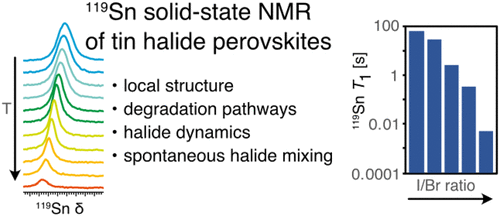Ask for a reprint
email :
* Give your email
2020
ACL
|
D.Kubicki, D.Prochowicz, E.Salager, A.Rakhmatullin, C.Grey, L.Emsley, S.D.Stranks, 'Local structure and dynamics in methylammonium, formamidinium and cesium tin(II) mixed−halide perovskites from 119Sn solid−state NMR', J. Am. Chem. Soc. 142 7813-7826 (2020) doi:10.1021/jacs.0c00647
Organic−inorganic tin(II) halide perovskiteshave emerged as promising alternatives to lead halide perov-skites in optoelectronic applications. While they suffer from considerably poorer performance and stability as compared to their lead analogues, their performance improvements have so far largely been driven by trial and error efforts due to a critical lack of methods to probe their atomic-level micro-structure. Here, we identify the challenges and devise a 119Sn solid-state NMR protocol for the determination of the local structure of mixed-cation and mixed-halide tin(II) halide per-ovskites as well as their degradation products and related phases. We establish that the longitudinal relaxation of 119Sn can span 6 orders of magnitude in this class of compounds which makes judicious choice of experimental NMR parame-ters essential for reliable detection of various phases. We show that Cl/Br and I/Br mixed-halide perovskites form solid alloys in any ratio, while only limited mixing is possible for I/Cl compositions. We elucidate the degradation pathways of Cs-, MA- and FA-based tin(II) halides and show that degrada-tion leads to highly disordered, qualitatively similar products, regardless of the A-site cation and halide. We detect the pres-ence of metallic tin amongst the degradation products, whichwe suggest could contribute to the previously reported high conductivities in tin(II) halide perovskites. 119Sn NMR chem-ical shifts are a sensitive probe of the halide coordination en-vironment as well as of the A-site cation composition. Finally, we use variable-temperature multi-field relaxation measure-ments to quantify ion dynamics in MASnBr3, establish activa-tion energies for motion and show that this motion leads to spontaneous halide homogenization at room temperature whenever two different pure-halide perovskites are put in physical contact.
|

|